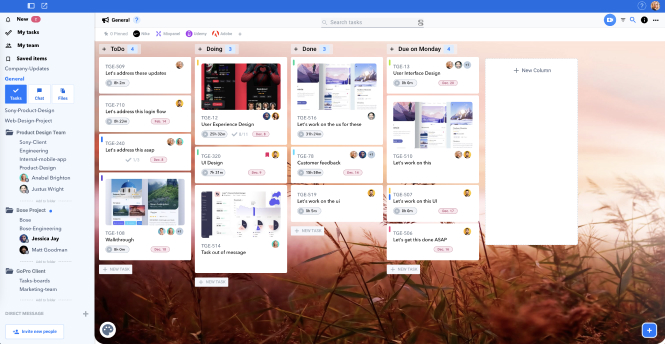Seamless teamwork is one of the most important attributes of productive teams. Effective communication leads to teamwork and efficient collaboration. These collectively make organizations more cohesive and improve business productivity.
But the challenges of remote and hybrid work coupled with the increasing complexity of projects have made communication and teamwork difficult. Statistics on teamwork prove how rolling out the right communication tools remains a challenge.
-
-
- According to Queen’s University, 75% of employers understand that teamwork and collaboration are important. But only 18% receive communication evaluation during performance reviews.
- A McKinsey survey found that most executives spend too much on pointless interactions that exhaust them and generate information overload.
- 39% of employees feel that individuals in their organizations don’t collaborate enough.
- 33% of employees believe that a lack of honest, open communication has the most negatively impacts their morale.
-
It’s evident that teamwork suffers from inefficient communication and that organizations should do more to promote collaboration. But what exactly are the problems that hinder efficient collaboration in a digital work environment?
Challenges for efficient teamwork
Based on Heycollab’s comprehensive analysis of digital work environments across sectors, these are the common problems that pose challenges to teamwork and collaboration.
1. Lack of clarity
Teamwork will suffer if employees don’t have clarity on project objectives and their contributions. What’s worse is that employees will be working hard, but those efforts will be misplaced and misaligned. 97% of executives and employees agree. They believe that lack of alignment negatively impacts project or task outcomes in their organizations.
2. Poor communication
Project management is affected by poor communication, which in turn leads to a loss of business productivity. According to a survey, more than 40% of employees feel that poor communication reduces their trust in their team and leadership. 54% of remote workers are affected by poor communication.
3. Time-zone differences
With time-zone differences, remote and hybrid employees will have different peak productivity times. This poses significant challenges to teamwork and project management. Without communication tools designed to solve the problems of asynchronous communication, remote team collaboration will be difficult.

4. Lack of transparency
Transparency creates trust and improves teamwork and business productivity. But organizations routinely fail to create a culture of transparency, even in a digital work environment. 60% of employees don’t have accurate information about their company’s goals. This leads to misunderstandings and inefficient outcomes.
5. Ineffective use of technology
Research shows that 70% of digital transformation initiatives that companies roll out don’t meet their targets. Only 16% of employees feel that their organization’s digital programs have improved productivity and are sustainable in the long term. One reason could be that technology is adopted without understanding specific requirements, negatively impacting teamwork.
6. Complex projects
Project management has become difficult because projects have become more complex. With more deliverables and shorter timelines, companies prioritize outcomes over teamwork. This leads to an inefficient use of resources and exhaustion among employees. Projects also have more cross-domain participation, which makes communication difficult.
7. Working in isolation
In a world of distributed teams, it’s difficult for employees to have direct, in-person interactions with their managers and colleagues. In the absence of dedicated channels for private communication, people end up working in silos. If communication systems are complex or tedious, they might resist reaching out with queries or concerns.
8. Meeting fatigue
Ironically, one of the hurdles in improving teamwork and efficient collaboration is meeting fatigue. Without a clear purpose or benefits, organizations and teams end up holding unnecessary meetings. Case in point: The average employee receives over 120 emails daily. This is how communication problems lead to fatigue, burnout, and higher rates of attrition.
9. Ineffective monitoring
Employees expect their managers to give timely feedback. This can only happen if leaders can seamlessly monitor progress updates. But in systems without a proper digital work environment, this is a problem. This creates delays because employees have to wait in uncertainty for approvals or suggestions.
10. Lack of access to resources
A crucial issue affecting teamwork is that employees may not have access to relevant data, policies, client specifications, market analyses, and other important information. They might be reluctant to initiate requests if they have to manually seek permission every time they need access. This forces employees to work without crucial information.

11. Suboptimal resource allocation
When managers don’t track the progress of employees’ tasks, they may not have a realistic assessment of their team members’ proficiencies. There could be duplication of skillsets, or teams may lack individuals with specific talents. These hinder teamwork and lead to project delays.
The solution: Heycollab
Organizations need the right technology solutions for seamless teamwork and efficient collaboration. If you’re a small or medium-sized business, marketing agency, e-commerce store, retailer, or freelancer, Heycollab is the platform you should be looking at. Why? Because it solves all the usual communication issues and fosters teamwork.
Heycollab was built with a specific belief that a productive platform need not be complex. Organizations searching for communication tools or project management software shouldn’t have to look at several places. With Heycollab, you get everything you need to enhance teamwork.
You get Docs, Tasks, Chat, Video Calling, Time Tracking, Dashboards, Docs, Templates, and a host of integrations. All under one roof. You can accomplish everything from performance reviews to project management using this advanced tool.
Heycollab saves you time and optimizes teamwork. Your team members can collaborate and communicate while having access to the resources they require. There’s no need to duplicate communication through email or other chat platforms.

Who’s Heycollab for?
Heycollab can foster teamwork, streamline communication, help manage projects effectively, and improve business productivity. It’s the communication tool you need if you are in any of these sectors:
-
-
- Creative: You can create compelling ideas and projects by understanding client requirements.
- Startups: Achieve more with less by having a centralized hub for organization and productivity.
- Education: Organize your teaching staff, students, and their work more effectively and give timely access to resources.
- Freelance: Manage your clients, projects, and deadlines more effectively through an easy-to-use platform.
- Small business: Streamline internal communication, monitor tasks, and give timely feedback to boost productivity.
- Nonprofit: Organize your mission, projects, team, and donors and easily monitor updates on your various efforts.
-
Heycollab features
As Heycollab’s clients have found out, these features can enhance teamwork and lead to efficient collaboration.
Chat
Heycollab comes with smart messaging and real-time chat to streamline teamwork. You can chat with anyone one-on-one or as a team in real-time. You can attach multimedia content to messages and create tasks from messages. You can also import conversations from Slack to Heycollab.
Use case: The client wants the campaign early? Simply create a new task from the message.
Tasks
Manage all your projects from start to finish with Tasks. You can change your viewing angle to a list, board, calendar, or timeline view to quickly asses metrics and progress. Tasks can have subtasks and child subtasks. Monitoring tasks is also exceptionally easy.
Use case: Just press play, and Heycollab will track your time on tasks. Now you know what’s taking too long.
Document sharing
Create and collaborate as a team with Docs. You can create folders with subsections to organize all your files for clutter-free and seamless collaboration. Moreover, you can share them across the platform through tasks and messages. This is how you get multiple members to work on docs at the same time.
Use case: Got customer feedback on your products? Bring it all together and create a market research presentation.
Time Tracking
With Time Tracking, you can input time manually, make adjustments, or visualize your progress toward your hourly goals. You can also view reports across workspaces, tasks, or teams. This reveals not just the amount of hours you work but the business outcomes you create.
Use case: Freelancers can use it to understand the value of their work for projects. By calculating hourly rates, you can easily find out how much you should charge.
Video Calling
Unlike most collaboration tools, Heycollab also comes with Video Calling. You can conduct audio, video, one-on-one, or team calls with fewer interruptions. What’s more, you can enable close captioning and subtitles. You can also customize your background. In-call polls, call recording, and screen sharing are some of the other features.
Use case: Record a product demo and share it with your remote and hybrid team members or agency partners. Or, conduct a poll on your latest features while you share them on video.
Conclusion
Effective collaboration is key to teamwork. You can enhance communication and business productivity by choosing the right platform to bring your team together. As a feature-rich and affordable teamwork tool, Heycollab is one of the most effective solutions you will ever find. Sign up for free, book a demo, or get in touch with us for more information.

